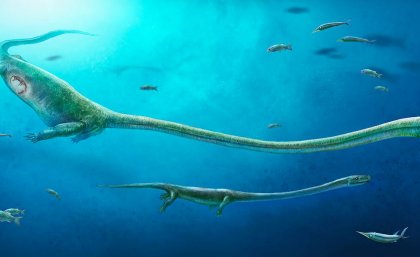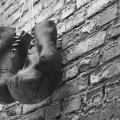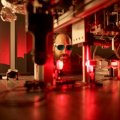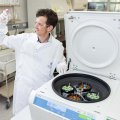
A remarkable 250 million-year-old “terrible-headed lizard” fossil found in China shows an embryo inside the mother – clear evidence for live birth.
University of Queensland School of Earth and Environmental Sciences Head Professor Jonathan Aitchison said the Dinocephalosaurus fossil provided the first evidence for live birth in an animal group previously thought to exclusively lay eggs.
“Live birth is well known in mammals, where the mother has a placenta to nourish the developing embryo,” Professor Aitchison said.
“Live birth is also very common among lizards and snakes, where the babies sometimes ‘hatch’ inside their mother and emerge without a shelled egg.”
Until recently it was thought the third major group of living land vertebrates, the crocodiles and birds (part of the wider group Archosauromorpha), only laid eggs.
“Indeed, egg-laying is the primitive state, seen at the base of reptiles and in their ancestors such as amphibians and fishes,” Professor Aitchison said.
He said the new Dinocephalosaurus fossil, was an archosauromorph, a long-necked marine animal and distant relative of the crocodile that flourished in the shallow seas of South China in the Middle Triassic Period.
The creature was a fish-eater, snaking its long neck from side to side to snatch its prey.
Its fossil was one of many astonishingly well-preserved specimens from Luoping Biota sites in south-western China. There are no known fossils of marine vertebrates of this age in from Australia.
Lead researcher Professor Jun Liu, from Hefei University of Technology China, said the researchers were “excited” when they first saw the specimen.
“We were not sure if the embryonic specimen was the mother’s last lunch or its unborn baby,” Professor Liu said.
“Upon further preparation and closer inspection, we discovered something unusual.
“Further evolutionary analysis revealed the first case of live birth in such a wide group containing birds, crocodilians, dinosaurs and pterosaurs, among others, and pushes back evidence of reproductive biology in the group by 50 million years,” Professor Liu said.
“Information on reproductive biology of archosauromorphs before the Jurassic Period was not available until our discovery, despite a 260-million-year history of the group.”
Fellow researcher Professor Chris Organ, from Montana State University, said evolutionary analysis showed that this instance of live birth was also associated with genetic sex determination.
“Some reptiles today, such as crocodiles, determine the sex of their offspring by the temperature inside the nest,” he said.
“We identified that Dinocephalosaurus, a distant ancestor of crocodiles, determined the sex of its babies genetically, like mammals and birds.”
The research, published in the journal Nature Communications, is part of an ongoing collaboration between palaeontologists in China, the United States, the UK and Australia.
Media: Professor Jonathan Aitchison, sees.hos@uq.edu.au, +61 7 3346 7010; Professor Jun Liu, junliu@hfut.edu.cn .










